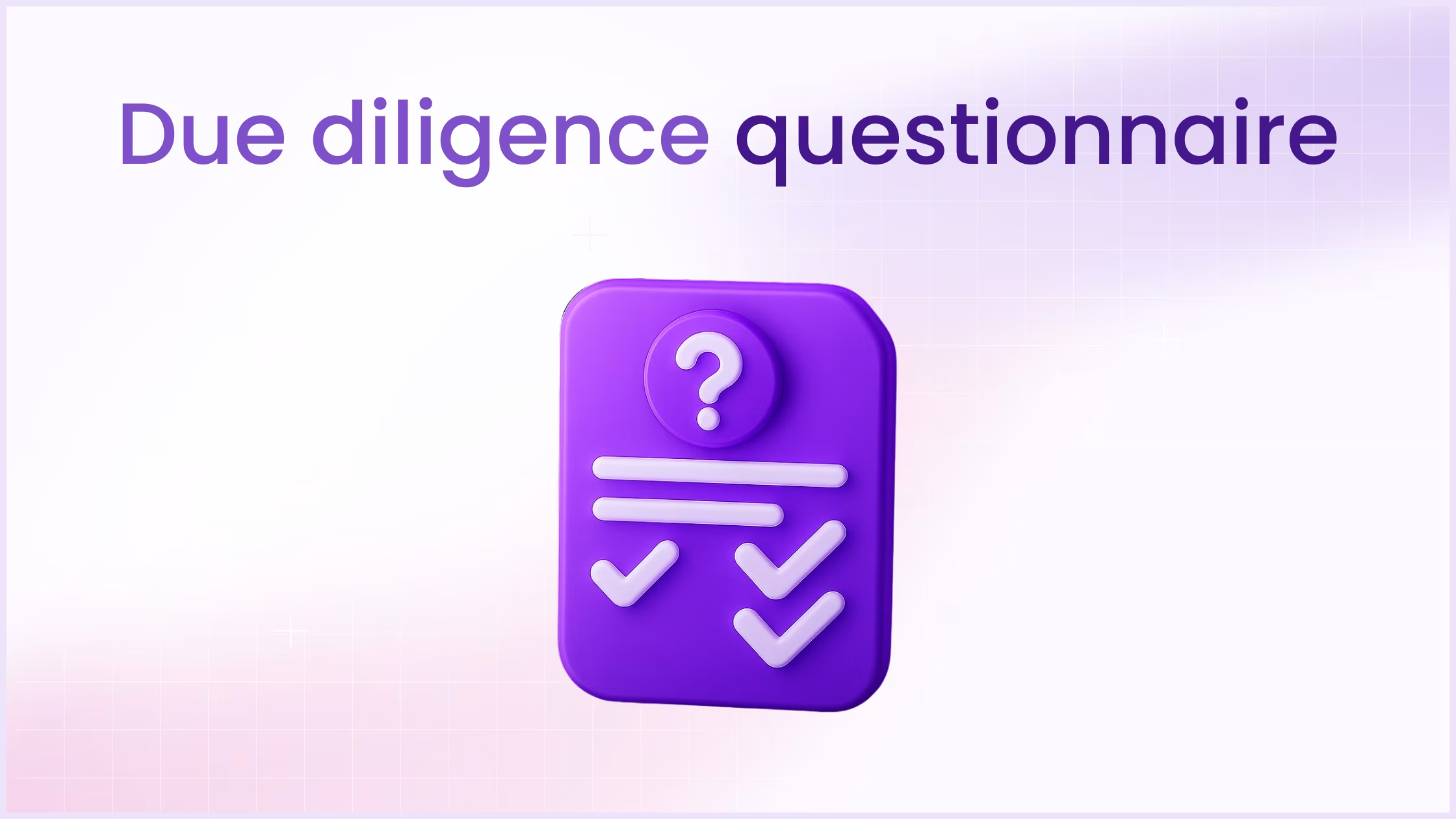Managing due diligence questionnaires (DDQs) is one of the most resource-intensive but mission-critical activities in investment, compliance, and fundraising operations. As organizations grow more interconnected and regulatory expectations rise, the volume and complexity of these questionnaires demand a smarter, more streamlined approach.
This guide explores how to transform your DDQ process from a manual, high-effort workflow into an efficient, repeatable system that supports strategic goals without sacrificing accuracy or compliance.
DDQ meaning: What it is and why it matters
A DDQ or due diligence questionnaire is a structured information-gathering document used to evaluate potential investments, partnerships, or vendors. For those new to this, understanding "what is a DDQ" or "what is a due diligence questionnaire" is foundational. It encompasses critical categories such as compliance policies, financial statements, business continuity, information security, and operational risk.
Why due diligence questionnaires matter
- Risk assessment: Understand exposures before making commitments.
- Regulatory compliance: Demonstrate adherence to evolving regulatory frameworks.
- Decision-making: Equip stakeholders with verified, relevant insights.
- Reputation management: Reduce reputational risk through robust vetting.
- Operational efficiency: Prioritize resources where the risk is highest.
In short, a well-managed due diligence process is not just a back-office function, it’s a strategic lever for investment firms, hedge funds, and asset managers.
Here is a set of guidelines from AIMA which includes industry-standard DDQ templates and sound practice guides used by hedge funds, private equity firms, and investors
DDQ vs RFP vs Security questionnaires
While all three documents - DDQs, RFPs, and security questionnaires serve as formal information requests, they target distinct outcomes within the broader due diligence process.
- A DDQ is typically focused on verification. Used heavily by institutional investors like limited partners and investment consultants, it examines operational due diligence, financial health, compliance posture, and overall risk management. These are especially common in private equity due diligence and hedge fund due diligence contexts.
- An RFP (Request for Proposal) is geared toward solution evaluation. It solicits detailed proposals from vendors, comparing them on scope, pricing, timelines, and alignment with business needs. RFPs are common in procurement and digital transformation initiatives where solution fit is paramount. You can read more about RFPs here.
- A Security Questionnaire zeroes in on information security, cyber risk, and data protection protocols. These are often required during vendor onboarding, IT audits, or as part of third-party risk assessments. They assess technical safeguards, data access controls, compliance with frameworks like ISO or SOC 2, and incident response readiness.
Each type of questionnaire plays a specific role. Aligning your workflows and content strategies with their intent ensures faster turnaround, better response quality, and stronger stakeholder trust.
Build your DDQ foundation right
1. Assign clear ownership
Effective DDQ management requires clear ownership. Cross-functional input is essential, but a dedicated coordinator often in investor relations or risk is key. This person oversees coordination with subject matter experts and ensures consistent quality assurance.
2. Create a centralized content library
A centralized content library accelerates response efficiency and maintains response quality. It captures pre-approved answers and improves knowledge sharing across business units. This content management approach reduces the burden of manual input and allows for easier audit trails.
3. Standardize your workflow
Mature organizations document a structured response management process:
- Complexity and risk assessment
- Allocation to subject matter experts
- Use of pre-existing modular content
- Compliance review
- Quality assurance checks
- Final approval and archival
Such a standardized workflow improves both response time and content accuracy.
4. Ensure consistency across channels
Consistency matters. DDQ responses are often cross-checked against websites, pitch decks, client reporting, and regulatory filings. Content governance committees ensure content aligns with broader messaging, protecting against reputational risk.
Due diligence questions: Smart strategies for smarter responses
Keep content current
Asset managers and fund managers operate in fast-changing environments. Implementing quarterly reviews prevents outdated information and ensures responses reflect your latest investment strategy and business model.
Modularize your answers
Using modular content blocks allows for swift customization, enabling firms to address DDQ requests without starting from scratch. This reduces dependency on ad hoc responses and simplifies compliance review.
Capture and reuse content
Turn every unique question into a knowledge asset. Tag and store new answers immediately in your library. Over time, this continuous improvement model supports digital transformation and enhances institutional knowledge.
Align with compliance schedules
Sync your review processes with compliance calendars. This ensures all responses remain aligned with the latest compliance policies and regulatory changes.
DDQ template and structure: What works best
A flexible due diligence questionnaire template provides structure while allowing for tailored responses. Key sections typically include:
- Company Overview
- Information security
- Financial risk and statements
- Business continuity
- Cyber risk and third-party risk
- Investment due diligence
- Operational risk
- Compliance and governance
This approach supports investment management teams in presenting a coherent narrative across varied DDQ challenges.
Hedge fund DDQ: A specialized use case
A hedge fund due diligence questionnaire dives deep into liquidity strategy, portfolio transparency, and operational infrastructure. For private equity firms, a private equity due diligence questionnaire might include sections on governance, ESG, and limited partner reporting. Both require a detailed understanding of vendor due diligence and third-party oversight.
Automating DDQs: The technology advantage
Manual workflows are prone to error and inefficiency. DDQ software offers clear automation benefits from question classification to content reuse. Using a collaborative platform enables seamless coordination across teams.
Advantages of smart tools
- Faster response time and fewer manual tasks
- Enhanced accuracy through pre-approved content
- Integrated compliance tracking and audit trails
- Scalable processes for growing DDQ volumes
Digital solutions empower investment firms to gain a competitive advantage by reducing redundancy, improving response quality, and freeing up bandwidth.
Due diligence questionnaire example: What excellence looks like
A strong due diligence questionnaire example would showcase:
- Customized jurisdictional content
- Integrated references to compliance policies
- Consistent messaging across submissions
- Professionally formatted responses
Such quality reflects a firm’s operational maturity and inspires trust among institutional investors.
From diligence questions to fundraising intelligence
Every vendor due diligence questionnaire contains insights into market research trends and investor priorities. Firms should analyze recurring diligence questions to fine-tune their value proposition and highlight strengths proactively.
Tracking feedback from DDQs informs how investment firms position themselves in competitive fundraising environments. DDQ optimization becomes more than compliance, it becomes strategic.
Turning your DDQ into your competitive edge with SiftHub
Optimizing your due diligence questionnaire process isn’t just a matter of best practices, it’s about enabling execution at scale. That’s where technology makes the difference between marginal improvements and transformational gains.
SiftHub helps organizations operationalize DDQ excellence through an AI-powered platform purpose-built for high-volume, cross-functional response processes. Instead of fragmented content, manual reviews, and delayed submissions, teams using SiftHub gain:
- Faster completion with AI-powered autofill that understands context and reuses approved answers
- Centralized knowledge access through enterprise-wide search across apps and repositories
- Stronger response quality with a continuously updated smart Q&A library that ensures consistency and traceability
- Seamless collaboration via task automation, in-document reviews, and real-time progress tracking
- Minimal disruption with native integration into tools your team already uses, like Google Docs, Word, Excel, and vendor portals
Whether you’re navigating investor DDQs, vendor due diligence, or M&A due diligence, SiftHub’s platform eliminates the friction points that slow teams down and compromise quality. The result: dramatically faster response cycles, increased productivity, and stronger confidence in every submission.
The future of due diligence isn’t just faster, it’s smarter, more reliable, and fully integrated. SiftHub helps you get there.
Ready to reimagine your DDQ process? Let’s talk.
Prompt suggestion
“Act as a compliance and investment due diligence expert. Create a professional and comprehensive Due Diligence Questionnaire (DDQ) template designed for investment firms, hedge funds, or private equity managers.
The DDQ should:
- Include clearly labeled sections: company overview, financials, compliance & governance, information security, business continuity, operational risk, and investment strategy
- Contain a mix of open-ended and yes/no questions
- Be modular so firms can tailor it by use case (vendor onboarding, investor due diligence, third-party risk)
- Ensure coverage of regulatory, legal, and reputational risk
- Be formatted for clarity and easy sharing
Make sure the DDQ is structured, easy to fill out, and supports both risk assessment and compliance goals.
Use “create a due diligence questionnaire” as the main focus. Keep the tone formal, professional, and practical.”







.avif)
.avif)

